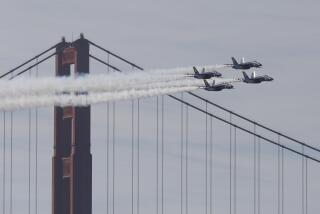Hitting the Carrier Deck for a Night of Excitement
- Share via
Our aircraft circled lazily above the Pacific Ocean off the starboard side of the carrier Nimitz.
Once it was cleared for landing, the two engines came alive and the plane carrying 26 passengers and cargo lurched forward. The aircraft jerked into a hard left turn as it prepared for the final approach to the small deck below.
The Nimitz was sailing 60 miles off Baja California when our plane hit the deck and came to a screeching halt with the help of a large cable and a hook on the tail of the prop plane. The stop was much more sudden than I ever imagined.
As the plane rolled to a stop near the bridge of the aircraft carrier, curious deck crew members wearing helmets, goggles and bright green, yellow and drab brown life vests gathered around to catch a quick look at the next batch of landlubbers to visit the ship.
“Wait until you take off,” one of the crew members yelled above the noise.
I was among a group of reporters and photographers who flew to the Nimitz two weeks ago from North Island Naval Air Station in San Diego to write stories about pilots from the El Toro Marine Corps Air Station making their first nighttime carrier landings, a task that even most veteran pilots call hair-raising.
Once aboard, we were given a briefing, shown to our room (which cost $17 a night per person and was called the “Hilton”) and taken to meet Capt. Robert C. Williamson, the commanding officer of the 1,092-foot-long ship from Bremerton, Wash. The nuclear-powered carrier and its 6,000-member crew recently returned from the Persian Gulf.
Inside the supercarrier, the passageways and doorways look almost identical and run on endlessly like one of those mirrors in a swanky restroom that shows the same image over and over. I found that the ship--all 18 stories of it from keel to mast--is an ideal place to become lost. But I quickly figured out how to get from my room to the nearby mess hall, one of many that serve as many as 18,000 meals a day.
The real action was on the deck and the best view of it was from the “bubble,” a small, windowed bump on the deck between the two main catapults in the front of the ship. It is there that the button is pushed which triggers the steam catapults that hurdle the F-14 Tomcats, F/A-18 Hornets, A-6 Intruders and the EA-6B Prowlers from the deck at 170 m.p.h. After watching them hit that speed from a standstill in less than three seconds, I wondered about my departure from the carrier the next day.
An equally spectacular sight was the return of the aircraft. They would come across the back of the ship at 150 m.p.h., hook an arresting cable 4 inches off the deck and stop within 340 feet. The metal hooks dragging along the deck at night produced a light show of sparks, and the smell of grinding metal, burning rubber and jet fuel followed the ship.
Landing supersonic jets on small moving platforms appeared unnatural and inherently dangerous. Some feel it is so dangerous and so costly that Marine aviators who rarely are called upon to land on carriers should not be required to go through the training and qualification. Usually, the landings are done safely. But in 1981, as the Nimitz sailed in the Atlantic, a jet making a night landing on the carrier crashed, killing 14 crew members and injuring 45 others.
All the Marines from El Toro safely qualified the night we were there.
Now, it was time for us to return home.
They loaded us back into the same plane, a C-2A Greyhound, that we had arrived in the day before. We were told to strap ourselves in tightly because we were about to be catapulted from the carrier, the same way that other planes were hurdled from the deck. One apparent difference was all the people in my plane were sitting backwards, a position, the military says, that greatly improves the chances of survival in the event of a crash.
I knew as the pilot raced the engines that we were about to be launched from the deck and go from a standing start to 135 m.p.h. in less than three seconds. As the veterans would say, I was about to “take a cat shot.”
Someone yelled, “We’re out of heeeeeeere!”
There came a point when I thought the plane could not accelerate any more. It stopped suddenly. The thunder of the steam catapult was behind us.
There was a moment of serene quiet, which prompted troubled thoughts that maybe everything wasn’t working correctly. We were just kind of floating out there.
Then, the propellers grabbed ahold and the plane was flying again.
More to Read
Sign up for Essential California
The most important California stories and recommendations in your inbox every morning.
You may occasionally receive promotional content from the Los Angeles Times.













